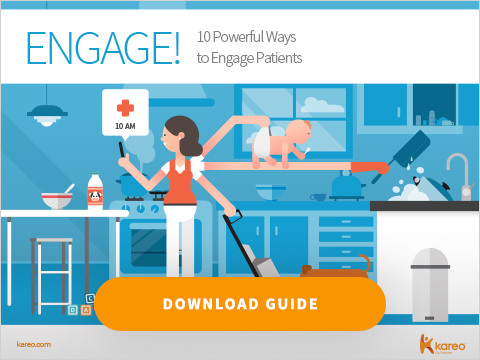Why Don’t Patients Use the Portal? Three Common Barriers and How to Overcome Them
Douglas Brown was raised in a small southern town, but now lives at the fringes of a metro area that has been swallowing the surrounding county for the past 20 years. He often feels his way of life is being threatened. Emails have replaced pen and paper. Instead of chatting on the front porch with his grandchildren, he carries on conversations with them via text messages. As you can imagine, he’s a little sad about that and other ways modernization is changing things.
Douglas recently recounted an experience to me about his last doctor’s visit. Here’s how it went:
He stopped by the front desk after his exam, reached through the open glass window and handed his papers to Wendy, the receptionist for his primary care physician.
“Thank you, Mr. Brown, your blood work results should be available in the portal as soon as the doctor has had time to review them,” she said with a smile.
Douglas looked away to think for a second. “I don’t have an account. Can someone just give me a call?”
Wendy replied, “Well certainly, Mr. Brown, but it may take longer before you get your results. Why don’t you take this brochure on our portal features?” Wendy flipped open the brochure and pointed to a trifold page. “If you decide to sign up, the information is all here.”
Shuffling the brochure back and forth in his hands as he left the office, Douglas finally tossed it onto the passenger’s seat of his car before driving home.
At age 63, he is not excited about changing the way he interacts with his doctor’s office. He’s been told that computers will simplify the way that business is done, but to him, it only seems to complicate matters.
Now more than ever, the healthcare system is looking to patient portals with high hopes for improving patient outcomes. Yet everyone, from technology producers to healthcare lawmakers, continue to be perplexed by low usage rates. There are a number of reasons this continues to be a problem, but Douglas’ story points to the top three.
Cultural Barriers
Growing up, Douglas knew his doctor. He knew his doctor’s family. Now his doctor is just one professional in a large practice that is part of an even more extensive medical system. For many like Douglas, the culture of community traditionally experienced in rural America contrasts sharply with the globalization of the internet. This cultural barrier to technology can be found across various geographies and ethnic backgrounds as well.
For instance, The Journal of Medical Internet Research published an article in 2016 titled, “I Want to Keep the Personal Relationship With My Doctor”: Understanding Barriers to Portal Use among African Americans and Latinos.” Some of the principal findings showed that “... participants expressed worry that the portal could undermine their existing in-person relationships with their healthcare providers.” It goes on to note “these findings are particularly important because of the well-documented lower portal use within these two racial/ethnic groups across healthcare systems.”
Technological Barriers
When looking at a broader cohort, technology seems to be a sticking point for many consumers. This is due to computer literacy, but the reasons behind said literacy (or lack there of) are diverse. Many regular healthcare consumers are part of an aging Baby Boomer or Silent Generation population that is not as comfortable with technology use as their Gen X and Millennial counterparts. Other consumers may struggle with computer literacy due to economic or educational deficits.
Douglas is not computer illiterate. He owns a laptop and a smartphone. In the ‘90s he considered himself a computer whiz, using desktops at his workplace, but the advent of the internet has caused technology to change far more rapidly than it did back then. The more features a program has, the more difficult he finds it to navigate said program, and with multiple sites requiring passwords, he struggles to remember what combination he used.
Lack of Information
Douglas is also unclear on how having an account on the patient portal would benefit him. What if he has a question about his test results? Will his doctor answer his electronic message personally or will it be answered by office staff he’s never met? He doesn’t understand what the portal could do for him that a simple phone call to his office couldn’t.
While most providers do have printed informational materials available, they are often handed out when patients are either preoccupied or stressed out by their appointment. This results in those brochures and flyers being discarded, left in vehicles or filed away, and when they are read, they can be difficult to understand because of medical or technical jargon.
It’s also important to note that many patients, even when informed about portal functions, don’t understand how it can be leveraged to benefit them directly. A large number of patient portals offer extremely helpful, time saving benefits such as online appointment scheduling and email communication with doctors and nurses, yet the number of patients that utilize these benefits continues to be on the low end due to lack of information.
Overcoming Barriers
If medical practices want to see an increase in patient portal use, they will have to address these three common barriers, which all revolve around the same problem -- the perceived or real deterioration between the close provider-patient relationship. Somehow, practices need to help patients see that using the patient portal doesn’t mean they’re losing out on close communication with their healthcare provider and the practice. In fact, it’s the very opposite.
Healthcare consultant Cheri Clancy, MSN, MS, RN, NEA-BC, CPXP offers these three actionable solutions:
1. Follow-Up: Whether this is a call or an email it should include a review of the patient portal. This allows your staff to review the benefits of the patient portal with the patient or family member in real time.
2. Reinforcement: As previously mentioned, it’s easy to disregard information when we’re in a public location looking at a pamphlet, which is why a little reinforcement can go a long way. Try making it standard practice to reach out to patients who aren’t already on the portal once every month to three months and walk them through the benefits it offers, as well as how they can access it.
3. Incentive: An incentive could be granted to patients who use the patient portal. For example, a 5% discount could be given off their next office visit once they’ve enrolled in the portal. This will get their foot through the door and show them how simple it is to use, making it more likely for them to return and utilize the many benefits a good patient portal has to offer.
After Douglas arrived home from his appointment, he stopped the car and looked at the brochure sitting on his seat. Out of resignation he pulled out his cell phone and called his daughter. He asked if he could come over later that evening to get help with creating an account for his patient portal.
She told him she’d be happy to help. “Can you also teach me how to use it?” he asked, and she assured him that she could. Douglas ended the call with a bit more hope.
We are happy Douglas ended up in this place of greater acceptance, but not all patients have access to friends and family that can explain things to them and/or help them when necessary. This is why it’s the responsibility of the providers to equip patients with the tools they need to successfully utilize patient portals.
For more information on how to help consumers adopt portal use, check out 11 Ways to Help Patients Adopt New Technology.




















